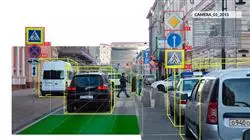University certificate
The world's largest artificial intelligence faculty”
Introduction to the Program
You will apply to your projects the most innovative techniques of Deep Learning thanks to this Professional master’s degree 100% online"

TensorFlow has become the most important tool for implementing and learning Deep Learning models. Developers use both its variety of tools and libraries to specialize models that perform automatic object detection, classification and natural language processing tasks. Along the same lines, this platform is useful for detecting anomalies in data, which is essential in areas such as cyber security, predictive maintenance and quality control. However, its use can involve a number of challenges for professionals, including the selection of the appropriate neural network architecture.
Faced with this situation, TECH implements a Professional master’s degree that will provide experts with a comprehensive approach to Deep Learning. Developed by experts in the field, the curriculum will delve into the mathematical foundations and principles of Deep Learning. This will enable graduates to build Neural Networks aimed at information processing involving pattern recognition, decision making and learning from data. In addition, the syllabus will delve deeper into Reinforcement Learning , taking into account factors such as reward optimization and policy search. In addition, the teaching materials will offer advanced optimization techniques and visualization of results.
As for the format of the university degree, it is delivered through a 100% online methodology so that graduates can complete the program with ease. To access the academic content they will only need an electronic device with Internet access, since the schedules and evaluation chronograms are planned on an individual basis. On the other hand, the syllabus will be supported by the innovative Relearningteaching innovative system, of which TECH is a pioneer. This learning system consists of the reiteration of key aspects to guarantee the mastery of its different aspects.
Study through innovative multimedia didactic formats that will optimize your Deep Learning update process"
This Professional master’s degree in Deep Learning contains the most complete and up-to-date program on the market. The most important features include:
- Practical cases studies are presented by experts in Data Engineer and Data Scientist
- The graphic, schematic and practical contents of the book provide technical and practical information on those disciplines that are essential for professional practice.
- Practical exercises where the self-assessment process can be carried out to improve learning
- Its special emphasis on innovative methodologies
- Theoretical lessons, questions to the expert, debate forums on controversial topics, and individual reflection assignments
- Content that is accessible from any fixed or portable device with an Internet connection
Looking to enrich your practice with the most advanced gradient optimization techniques? Achieve it with this program in just 12 months"
The program’s teaching staff includes professionals from the field who contribute their work experience to this educational program, as well as renowned specialists from leading societies and prestigious universities.
The multimedia content, developed with the latest educational technology, will provide the professional with situated and contextual learning, i.e., a simulated environment that will provide immersive education programmed to learn in real situations.
This program is designed around Problem-Based Learning, whereby the professional must try to solve the different professional practice situations that arise during the academic year For this purpose, the students will be assisted by an innovative interactive video system created by renowned and experienced experts.
You will delve into the Backward Pass to calculate the gradients of the loss function with respect to the parameters of the network"

Thanks to the Relearning methodology, you will be free to plan both your study schedules and educational timelines"
Why study at TECH?
TECH is the world’s largest online university. With an impressive catalog of more than 14,000 university programs available in 11 languages, it is positioned as a leader in employability, with a 99% job placement rate. In addition, it relies on an enormous faculty of more than 6,000 professors of the highest international renown.

Study at the world's largest online university and guarantee your professional success. The future starts at TECH”
The world’s best online university according to FORBES
The prestigious Forbes magazine, specialized in business and finance, has highlighted TECH as “the world's best online university” This is what they have recently stated in an article in their digital edition in which they echo the success story of this institution, “thanks to the academic offer it provides, the selection of its teaching staff, and an innovative learning method aimed at educating the professionals of the future”
A revolutionary study method, a cutting-edge faculty and a practical focus: the key to TECH's success.
The most complete study plans on the university scene
TECH offers the most complete study plans on the university scene, with syllabuses that cover fundamental concepts and, at the same time, the main scientific advances in their specific scientific areas. In addition, these programs are continuously being updated to guarantee students the academic vanguard and the most in-demand professional skills. In this way, the university's qualifications provide its graduates with a significant advantage to propel their careers to success.
TECH offers the most comprehensive and intensive study plans on the current university scene.
A world-class teaching staff
TECH's teaching staff is made up of more than 6,000 professors with the highest international recognition. Professors, researchers and top executives of multinational companies, including Isaiah Covington, performance coach of the Boston Celtics; Magda Romanska, principal investigator at Harvard MetaLAB; Ignacio Wistumba, chairman of the department of translational molecular pathology at MD Anderson Cancer Center; and D.W. Pine, creative director of TIME magazine, among others.
Internationally renowned experts, specialized in different branches of Health, Technology, Communication and Business, form part of the TECH faculty.
A unique learning method
TECH is the first university to use Relearning in all its programs. It is the best online learning methodology, accredited with international teaching quality certifications, provided by prestigious educational agencies. In addition, this disruptive educational model is complemented with the “Case Method”, thereby setting up a unique online teaching strategy. Innovative teaching resources are also implemented, including detailed videos, infographics and interactive summaries.
TECH combines Relearning and the Case Method in all its university programs to guarantee excellent theoretical and practical learning, studying whenever and wherever you want.
The world's largest online university
TECH is the world’s largest online university. We are the largest educational institution, with the best and widest online educational catalog, one hundred percent online and covering the vast majority of areas of knowledge. We offer a large selection of our own degrees and accredited online undergraduate and postgraduate degrees. In total, more than 14,000 university degrees, in eleven different languages, make us the largest educational largest in the world.
TECH has the world's most extensive catalog of academic and official programs, available in more than 11 languages.
Google Premier Partner
The American technology giant has awarded TECH the Google Google Premier Partner badge. This award, which is only available to 3% of the world's companies, highlights the efficient, flexible and tailored experience that this university provides to students. The recognition as a Google Premier Partner not only accredits the maximum rigor, performance and investment in TECH's digital infrastructures, but also places this university as one of the world's leading technology companies.
Google has positioned TECH in the top 3% of the world's most important technology companies by awarding it its Google Premier Partner badge.
The official online university of the NBA
TECH is the official online university of the NBA. Thanks to our agreement with the biggest league in basketball, we offer our students exclusive university programs, as well as a wide variety of educational resources focused on the business of the league and other areas of the sports industry. Each program is made up of a uniquely designed syllabus and features exceptional guest hosts: professionals with a distinguished sports background who will offer their expertise on the most relevant topics.
TECH has been selected by the NBA, the world's top basketball league, as its official online university.
The top-rated university by its students
Students have positioned TECH as the world's top-rated university on the main review websites, with a highest rating of 4.9 out of 5, obtained from more than 1,000 reviews. These results consolidate TECH as the benchmark university institution at an international level, reflecting the excellence and positive impact of its educational model.” reflecting the excellence and positive impact of its educational model.”
TECH is the world’s top-rated university by its students.
Leaders in employability
TECH has managed to become the leading university in employability. 99% of its students obtain jobs in the academic field they have studied, within one year of completing any of the university's programs. A similar number achieve immediate career enhancement. All this thanks to a study methodology that bases its effectiveness on the acquisition of practical skills, which are absolutely necessary for professional development.
99% of TECH graduates find a job within a year of completing their studies.
Professional Master's Degree in Deep Learning
Discover the future of artificial intelligence with the Professional Master's Degree in Deep Learning offered by TECH Global University. This postgraduate program, designed for those looking to advance their understanding and application of deep learning, will immerse you in the fascinating world of deep neural networks and the practical applications of artificial intelligence, all from the comfort of our online classes. As academic leaders in the field, we understand the growing importance of deep learning in today's technology landscape. This Professional Master's degree is designed to provide you with the essential skills needed to develop advanced algorithms, understand complex artificial intelligence models and apply innovative solutions in a variety of fields. Our online classes, taught by experts, will provide you with a quality education relevant to contemporary challenges. You'll explore the latest trends in intelligent algorithm development, complex data analysis and neural network technologies, all while receiving guidance from experienced professionals in the field.
Study Deep Learning from your own home
This Professional Master's Degree not only focuses on theory, but also gives you the opportunity to apply your knowledge in practical projects. Through real-world case studies and applied projects, you will develop a deep and practical understanding of deep learning, preparing you to lead in the application of these technologies in demanding professional environments. At TECH, we are proud to offer a Professional Master's Degree that not only equips you with advanced knowledge in deep learning, but also prepares you to meet the challenges and capitalize on the opportunities in the constant evolution of artificial intelligence. Upon successful completion of the postgraduate program, you will receive a certificate endorsed by the world's best online university, validating your skills and expertise. This Professional Master's Degree not only represents an educational achievement, but also puts you in a prime position to excel in the competitive working world of artificial intelligence. If you are ready to transform your career and explore the frontiers of deep learning, join TECH Global University and open the door to an exciting future in artificial intelligence.







